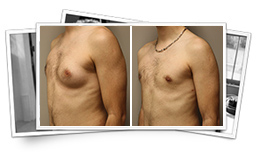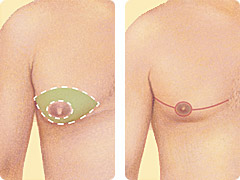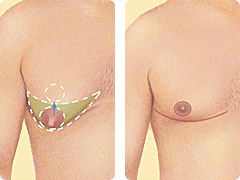Male Breast Reduction Thousand Oaks
Male breast reduction in Thousand Oaks is performed to address a condition known as gynecomastia. This condition involves the abnormal enlargement of the breast tissue. It can range from an enlarged nipple and areola to outright breasts similar to a woman’s.
Gynecomastia can be treated effectively based on the degree of gynecomastia. A slight enlargement of the breast tissue can be treated with ultrasonic liposuction alone. A moderate increase in breast size may require liposuction and the additional removal of tissue through a small incision on the border of the areola. Large breasts require removal of excess skin as well as the underlying breast tissue, resulting in scars around and under the areola.
Before & After Photos
 Male Breast Reduction
Male Breast Reduction
At the Kryger Institute of Plastic Surgery, we have experience in a vast array of surgical and non-surgical procedures. Click below to see some before and after photos of male breast reductions.
MORE MALE BREAST REDUCTION PHOTOS
 In large reductions an incision is required. The incision can be placed around the border of the areola and extending sideways in either direction.
In large reductions an incision is required. The incision can be placed around the border of the areola and extending sideways in either direction. In very large reductions the incision can be placed around the border of the areola and along the lower chest crease.
In very large reductions the incision can be placed around the border of the areola and along the lower chest crease.Who is a good candidate for male breast reduction?
Any man who is otherwise in good health and who has gynecomastia may be a candidate for gynecomastia surgery. Teenage boys with gynecomastia may also be considered for surgery.
It is important to determine if the enlarged breast tissue is due to an underlying hormonal imbalance since certain medical conditions can lead to this. In some cases, treating the underlying condition can result in an improvement in the enlarged breast tissue.
Planning your male breast reduction surgery
In your initial consultation, your surgeon will begin by evaluating your health. Be sure to tell your surgeon if you smoke, and if you’re taking any medications, vitamins, or other drugs. Some drugs, such as marijuana and anabolic steroids, can cause enlargement of the breasts.
Be sure to tell your surgeon how your chest has changed over time-both in terms of size and shape. Discuss any family history of breast cancer. The surgeon will then explain which surgical technique is most appropriate for you, based on the size and shape of your breasts. The surgeons at the Kryger Institute offer all types of male breast reduction, including the liposuction-only breast reduction.
Does insurance cover male breast reduction?
Some insurance companies cover the price of male breast reduction. However, this is done on a case by case basis. The Kryger Institute will do everything possible to work with your insurance carrier to obtain approval for your procedure. If the insurance company denies coverage for your surgery, the cost of surgery will be your responsibility. Make sure to speak to our patient care coordinator about these issues ahead of time.
Preparing for surgery
You will be told which medications to stop and which to take before surgery. Aspirin and anti-inflammatory medications such as ibuprofen and Aleve must be stopped for 7 days before surgery. If you smoke, you must quit smoking entirely for 6 weeks before and 6 weeks after surgery.
You must strictly follow the instructions about when to start fasting before surgery (usually at midnight). If you get sick or have any health issues in the days before surgery, please notify the office at once in case we have to postpone your operation.
The surgery and the incisions
The surgery usually takes 1-2 hours to complete. The type of incision you end up with is determined by how large and droopy (ptotic) your breasts are. Your surgeon will mark your chest before surgery and go over the incisions with you one final time.
Men with no excess skin and only enlarged nipple-areola regions may be candidates for liposuction only breast reduction. Breasts that are moderately large and slightly droopy can be reduced using liposuction and an additional incision that goes partially around the circumference of the areola. Large, female-like breasts will require an incision around the entire circumference of the areola and a second horizontal incision below the breast.
The anesthesia
Male breast reduction is often performed under general anesthesia. it can also be performed under “twilight” anesthesia for very small reductions. Twilight anesthesia consists of intravenous sedation and pain medication that keeps you relaxed and sleepy during the surgery. In addition, the surgeon uses local anesthesia to numb the abdomen.
General anesthesia involves going completely to sleep with a breathing tube in your throat. There is a slightly higher risk of nausea and vomiting after general anesthesia, however both techniques are extremely safe. Your surgeon will discuss the anesthetic options with you before surgery.
What kind of dressings and drains are there?
Your chest will be wrapped with an ACE wrap over gauze. You can remove the gauze dressings the day after surgery. If there is tape or adhesive strips directly on your incision, do not remove these. If they fall off in the shower there is no need for concern.
Breast reduction surgery does not routinely require the use of drains. Very large reductions (especially if combined with liposuction) may require one drain in each breast. This will be determined by your surgeon at the time of surgery. These drains help drain the fluid that is produced under your skin as part of the healing process. Without drains, this fluid can accumulate, termed a seroma.
Drains stay in until the drainage is less than 25 ml per drain in a twenty four hour period. This usually takes 3-5 days, but can be shorter or longer in some cases. The drains are easy to take care of, and do not hurt to take out.
Can you go home the day of male breast reduction surgery?
Male breast reduction is routinely performed as an outpatient, and most patients will be able to go home the same day. Some patients may prefer to spend a night in the hospital if they have young children at home or live alone and do not have any help at home.
How much pain is there after surgery?
Pain from a breast lift is highly variable and ranges from minimal to moderate. It is worst in the first few days after surgery, but then it rapidly improves. It is impossible to predict a person’s expected pain during recovery. If you have done well with surgery in the past, you will likely be fine after this surgery.
Our surgeons have a lot of experience treating pain, and have published scientific articles and written book chapters about anesthetics and pain control. They will do everything possible to minimize your pain, including using pain pumps after surgery and utilizing all the newest pain medication. By the end of the first week, most people’s pain is controlled with plain Tylenol or Motrin.
What about swelling and bruising?
Swelling and bruising are normal signs of the healing process. They occur after any surgery to varying degrees. Swelling peaks at about 48 hours, and then rapidly decreases. By the end of the first few weeks, 50 percent of the swelling is gone. During this early period, your breasts will appear larger than their final size due to the swelling. By 6-8 weeks, a majority of the swelling has diminished. By 6 months, all the swelling is gone.
Bruising is worst the day after surgery and then rapidly gets better. It is usually gone by two weeks. You may also experience a burning sensation in your nipples for up to two weeks, but this will subside as bruising fades.
What restrictions are there?
You can shower the day after surgery, but you should not bathe, use a hot-tub, or go swimming for at least two weeks. The first two days after surgery are usually spent doing minimal activity. Most patients then begin to get back to their regular routine. Within 3-5 days, you will probably be ready to leave the house for short trips and light walks. More vigorous walking and mild stretching exercises can be resumed about a week after surgery.
Strenuous activities such jogging, aerobics, weight-training should not be done until 3-4 weeks after surgery. Also, you shouldn’t do any heavy lifting (over 10 pounds) during this period. A good guide before beginning activities that involve direct contact to the breasts is to wait until pain and sensitivity in the breasts has resolved.
When can I travel?
Traveling after surgery (air travel, long distance car trips, train rides, etc) should not be done before you have had your first postoperative visit. Typically, this occurs 7-10 days after surgery. Patients who are at high risk for developing a blood clot should not travel until instructed by their surgeon.
Short car trips under 60 minutes can be done before the first visit. A good rule of thumb is when you are off the stronger pain medication and can get up without assistance, you are ready to go for a short drive. You should not drive the car yourself, however, until your surgeon gives you clearance for this.
When can I go back to work?
This, of course, depends on the kind of work you do. Most people go back to work after one week. Sedentary jobs, such as computer work or talking on the phone can begin even sooner. If you have a strenuous job that involves a lot of lifting or physical activity, you may have to wait 2 weeks until you are ready for work. Please review the restrictions for further guidelines about getting back to work.
What kind of scars can I expect?
Scarring is an unpredictable part of any surgery. It is impossible to cut through the full thickness of the skin and not have a scar. For most patients, the incisions from male breast reduction heal well and do not become bothersome scars. Our surgeons have published numerous scientific papers about the scarring process and wound healing, and will do everything possible to minimize scarring.
To a large extent, however, scarring is determined by your genetics. If you are prone to hypertrophic (wide, raised) scars or keloids, make sure to inform your surgeon ahead of time. Our surgeons will use all the available techniques to minimize your scars based on their extensive research experience on hypertrophic scarring.
Your scars will be firm and pink for at least six weeks. After six weeks, scars are very strong and can withstand any activity. Then they may remain the same size for several months, or even appear to widen. After several months, your scars will begin to fade, although they will never disappear completely. It takes 1-2 years for a scar to completely heal. Make sure to apply sunscreen containing zinc-oxide to your scars for six months so that they do not darken due to increased pigmentation.
What if I have a problem? When should I call the office?
The Kryger Institute welcomes calls from patients. If you have any concerns at any time, please feel free to call our office. If it is an emergency, the answering service is available 24 hours a day, including weekends and holidays. There is always a plastic surgeon on call. Your surgeon will discuss all the risks and potential complications with you before surgery. You will receive detailed instructions about situations that warrant a call to the office.
Arrange your consultation
The best way to get started with male breast reduction in Thousand Oaks is with a consultation. To set up your consultation and find out more, contact our office today.

